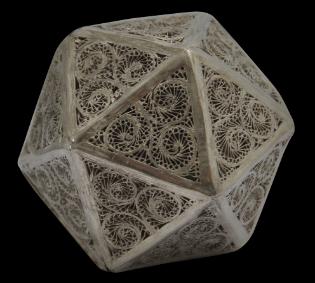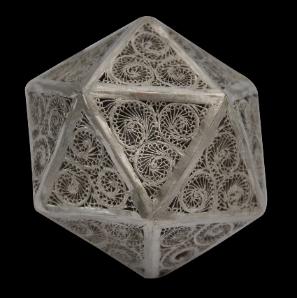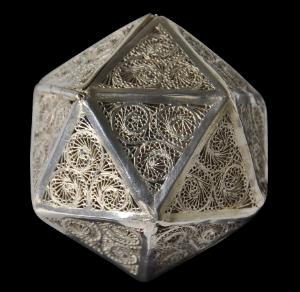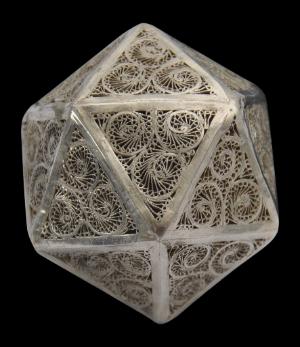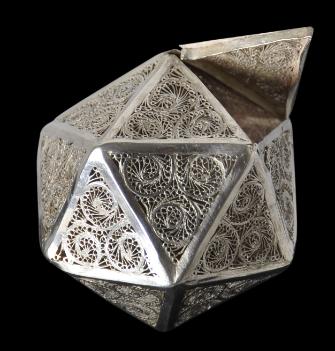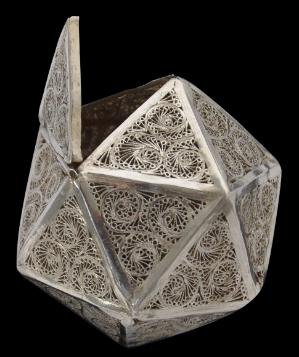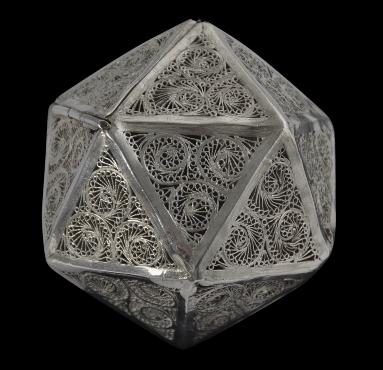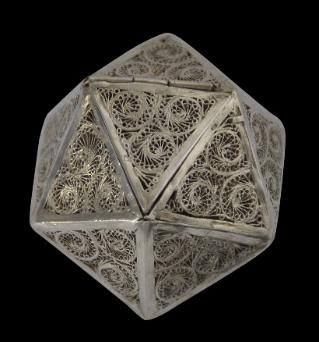
Indian Market Silver Filigree Icosahedran
Rare Silver Filigree Box in the form of an Icosahedron
made for the Indian Market
18th century
height & width (approx.): 4.3cm, weight: 25g
This extraordinary and rare box is hollow and has twenty triangular sides. Each side is made of particularly fine, solid silver filigree. One of the triangular sides is hinged and opens, permitting access to the interior.
The form fits into the oeuvre of scientific and mathematical devices in the Islamic world, perhaps tempered with mysticism and notions of magic. It is also known in gaming and has been used as a rare type of dice based on the Platonic solid known as an icosahedron consisting of 20 equilateral triangle faces that meet five to a corner. Each side of such a dice is numbered from one to twenty. With so many faces, such a dice is easy to roll, being almost spherical. Such dice appear to be more prevalent in the Islamic world, and generally are shaped from solid stone.
The example here appears to be the only known example composed of silver filigree. There is one other comparable and that is now in the Al Thani Collection – a hollow icosahedron made from sheet gold, illustrated in Stronge (p. 68). Each side is numbered in Arabic, but the numbers are not sequential and each number also ends in the number ‘1’. The box was appropriated by Robert Bell of the East India Company’s Madras Artillery at the fall of Seringapatam, near Mysore, in south India, in 1799. According to Stronge (2015, p. 68), Major Bell (later General) was one of the Prize Agents who dispersed the ruler Tipu Sultan’s treasury at Seringapatam.
The purpose of the Tipu Sultan box is unclear. Probably it is served some sort of talismanic purpose. According to Stronge (2015, p. 68) Professor Jacques Sesiano, a historian of mathematics in the Islamic world, has ruled out the box as a mathematical device, but mathematician Paul Bien in a paper presented to a North American conference in 2000 (see Bien, 2000) demonstrates that when the sum of the numbers on the lid are considered separately to the sum of the numbers on the remainder of the box, ratios that approximate to pi, the golden ratio and the square roots of 2, 3 and 5 can be generated. This must be more than mere coincidence. According to Bien, (pers. comm. 2016), ‘there are some strong similarities between these two icosahedra [the example here and the Tipu Sultan example]. In my original research I came across other icosahedra but nothing appears to have the similarities of these two icosahedra.’
The Tipu Sultan gold box was found in India. But that doesn’t mean it was made there. Various items apparently taken from Tipu Sultan’s treasury in museums today are assumed to be from India but that is probably wrong. Goods for presentation after all have more cache if they are exotic and imported.
Our example might have been made in India, but the filigree is more in keeping with filigree that is associated with 18th century Batavia or the West Coast of Sumatra in the Dutch East Indies (see Veenendaal, 2014 for a discussion on filigree produced in the Dutch East Indies but which is usually attributed to elsewhere). It is possible, perhaps likely, that it was made there for export for the Islamic market in India, perhaps as a diplomatic gift. Our example has an old, small Dutch import mark for foreign silver which bolsters the case that it was made in the Dutch East Indies, and perhaps was never sent to India. Most probably it was made in the Dutch East Indies at the behest of the Dutch East India Company (VOC) for the India market.
In terms of condition, all the panels are intact. There is wear to the extremities and minor losses to the filigree here and there. But essentially, any such condition issues are compensated for by the item’s rarity.
References
Bien. P., ‘A numbererd icosahedron from India: Mystery & Meaning’, paper presented to the Eighth Midwest History of Mathematics Conference, Northern Kentucky University, October 13-14, 2000.
Bien, P., pers. comm., March 2016.
Stronge, S., Bejewelled Treasures: The Al Thani Collection, V&A Publishing, 2015.
Veenendaal, J., Asian Art and the Dutch Taste, Waanders Uitgevers Zwolle, 2014.
Provenance:
Dutch art market; Dutch import mark for foreign silver
Inventory no.: 3452
SOLD

